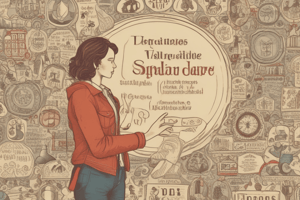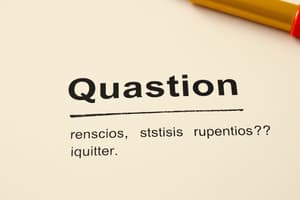Podcast
Questions and Answers
Which sentence correctly uses the verb 'estar' to describe a temporary condition?
Which sentence correctly uses the verb 'estar' to describe a temporary condition?
- Nosotros somos estudiantes de español.
- Ella es alta y simpática.
- Tú eres mi amigo.
- Él está enfermo hoy. (correct)
In which context should the verb 'estar' be used instead of 'ser'?
In which context should the verb 'estar' be used instead of 'ser'?
- To discuss a person's personality.
- To describe someone's nationality.
- To express the location of a person. (correct)
- To indicate a permanent job title.
What is the correct conjugation of 'estar' for 'yo' in the present tense?
What is the correct conjugation of 'estar' for 'yo' in the present tense?
- Estás
- Soy
- Está
- Estoy (correct)
To describe a friend's mood, which form of 'estar' would be appropriate?
To describe a friend's mood, which form of 'estar' would be appropriate?
Which of the following sentences incorrectly uses 'ser' or 'estar'?
Which of the following sentences incorrectly uses 'ser' or 'estar'?
Which scenario correctly illustrates the use of estar?
Which scenario correctly illustrates the use of estar?
In which situation is the verb estar used incorrectly?
In which situation is the verb estar used incorrectly?
Which sentence best demonstrates the use of estar in indicating location?
Which sentence best demonstrates the use of estar in indicating location?
What does the phrase 'Estoy enfermo' indicate about the subject?
What does the phrase 'Estoy enfermo' indicate about the subject?
Which example uses estar to express an ongoing action?
Which example uses estar to express an ongoing action?
What type of expression would best precede the verb estar?
What type of expression would best precede the verb estar?
Which of the following sentences uses estar to indicate a future event?
Which of the following sentences uses estar to indicate a future event?
Which of these sentences highlights the temporary nature of a feeling using estar?
Which of these sentences highlights the temporary nature of a feeling using estar?
Which of the following correctly identifies an example of an AR verb?
Which of the following correctly identifies an example of an AR verb?
What is the correct first-person singular present tense conjugation for the verb 'hablar'?
What is the correct first-person singular present tense conjugation for the verb 'hablar'?
Which ending should be used for 'we' when conjugating an AR verb?
Which ending should be used for 'we' when conjugating an AR verb?
How do you derive the stem of the verb 'cantar' for conjugation?
How do you derive the stem of the verb 'cantar' for conjugation?
What is the correct conjugation for 'you (plural, informal)' when using the verb 'buscar'?
What is the correct conjugation for 'you (plural, informal)' when using the verb 'buscar'?
Which of the following is true regarding irregular AR verbs?
Which of the following is true regarding irregular AR verbs?
What might happen when using the conjugation chart for AR verbs?
What might happen when using the conjugation chart for AR verbs?
Which of the following is NOT an example of an AR verb?
Which of the following is NOT an example of an AR verb?
Flashcards
Question Words in Spanish
Question Words in Spanish
Spanish question words like ¿Cómo?, ¿Qué?, ¿Cuándo?, ¿Dónde?, ¿Por qué? are used to ask for specific information. They are placed before the subject and verb.
Describing People in Spanish
Describing People in Spanish
Use adjectives like 'alto' (tall) or 'baja' (short) to describe people's physical characteristics.
Describing Places in Spanish
Describing Places in Spanish
Use prepositions like 'en' (in), 'de' (from), 'a' (to), 'sobre' (on), 'dentro de' (inside) to show location.
Using the verb 'ser' in Spanish
Using the verb 'ser' in Spanish
Signup and view all the flashcards
Using the verb 'estar' in Spanish
Using the verb 'estar' in Spanish
Signup and view all the flashcards
When is estar used for location?
When is estar used for location?
Signup and view all the flashcards
What does estar describe?
What does estar describe?
Signup and view all the flashcards
How can you remember when to use ser?
How can you remember when to use ser?
Signup and view all the flashcards
When should you use estar?
When should you use estar?
Signup and view all the flashcards
What does estar + gerund describe?
What does estar + gerund describe?
Signup and view all the flashcards
What does estar + adjective describe?
What does estar + adjective describe?
Signup and view all the flashcards
What does "La fiesta está mañana." mean?
What does "La fiesta está mañana." mean?
Signup and view all the flashcards
How are time expressions used with estar?
How are time expressions used with estar?
Signup and view all the flashcards
What are AR verbs in Spanish?
What are AR verbs in Spanish?
Signup and view all the flashcards
What is the AR verb conjugation chart?
What is the AR verb conjugation chart?
Signup and view all the flashcards
How do you conjugate AR verbs in the present tense?
How do you conjugate AR verbs in the present tense?
Signup and view all the flashcards
Explain how to conjugate "hablar" (to speak) in the present tense.
Explain how to conjugate "hablar" (to speak) in the present tense.
Signup and view all the flashcards
What are irregular AR verbs?
What are irregular AR verbs?
Signup and view all the flashcards
Why is practicing AR verbs important?
Why is practicing AR verbs important?
Signup and view all the flashcards
How does mastering AR verbs help with speaking Spanish?
How does mastering AR verbs help with speaking Spanish?
Signup and view all the flashcards
What is the benefit of mastering AR verbs?
What is the benefit of mastering AR verbs?
Signup and view all the flashcards
Study Notes
Question Words in Spanish
- Spanish uses question words like ¿Cómo?, ¿Qué?, ¿Cuándo?, ¿Dónde?, ¿Por qué?
- These words are placed with the subject and verb in the sentence when asking a question.
- Examples of using question words to ask for information: ¿Cómo estás? (How are you?), ¿Cómo te llamas? (What is your name?).
- Common question words include: ¿Qué?, ¿Quién?, ¿Quiénes?, ¿Cuándo?, ¿Dónde?, ¿Cómo?, ¿Cuál?, ¿Cuánto?, ¿Cuántos?, ¿Cuántas?, ¿Por qué?.
Describing People and Places
- Describing people: Use adjectives with the correct gender and number to introduce physical characteristics, e.g., alto (tall - masculine), baja (short - feminine), inteligente (intelligent), simpático (friendly).
- Describing places: Use prepositions like en, de, a, sobre, dentro de to describe location.
Family Members
- Learn basic family members: father, mother, brother, sister, etc.
- Use of verbs ser and estar with family relationships: The choice of verb depends on the context/situation being described.
Verbs
- Use the verb ser to describe permanent characteristics or attributes.
- Use the verb estar to describe temporary or relational characteristics.
- Verb conjugation follows patterns specific to each tense.
- Estar is used for temporary states or locations, not permanent qualities.
Understanding Estar
- Estar is a Spanish verb often translated to "to be" but differs from English "to be".
- Estar expresses the state of something or someone at a particular time; a temporary condition or location.
- Estar isn't for permanent states or characteristics; use ser for those.
Distinguishing Estar from Ser
- Use ser for inherent qualities: El libro es rojo (The book is red) – Redness is permanent.
- Use estar for changing conditions or temporary predicaments: El libro está sobre la mesa (The book is on the table) – Location is temporary. Estoy cansado (I am tired.) – Tiredness is temporary.
Common Uses of Estar
- Location: Expressing where something is at a specific moment: El gato está en la caja. (The cat is in the box.)
- Physical condition: Describing a temporary physical state: Estoy enfermo. (I am ill.), Ella está cansada. (She is tired.)
- Emotional state: Describing a temporary emotional state: Estoy feliz. (I am happy.), Ellos están enojados. (They are angry.)
- Actions in progress: Expressing ongoing actions at a moment in time: Estoy estudiando. (I am studying.), Ellos están jugando. (They are playing.)
- Time expressions: Expressing location in time, like ahora, hoy, and esta semana: La fiesta está mañana. (The party is tomorrow.), Estamos en diciembre. (We are in December.)
Location vs. Temporary Condition
- Distinguishing between location and temporary conditions can be subtle; the choice often depends on the overall meaning.
Estar in Special Constructions
- Estar + gerund (present participle): Describes an action in progress at a particular moment: Estoy comiendo. (I am eating.), Ella está leyendo un libro. (She is reading a book.)
- Estar + adjective (describing emotions and states): Common in expressions describing feelings and conditions: Estoy feliz hoy. (I am happy today.), Ella está enojada conmigo. (She is angry with me.)
AR Verbs
- AR verbs are common in Spanish.
- They are more frequent than ER or IR verbs.
- AR verbs end in “ar”.
- Examples include hablar, cantar, and buscar.
The Present Tense Conjugation of AR Verbs (Chart)
- A chart is used to understand and apply AR verbs.
- It includes three columns (I, You formal, He/She/You formal) and two rows (We, You informal, They/You formal)
- The chart headings are consistent.
- Use the chart to conjugate AR verbs.
Using the Chart
- Take the infinitive form of the verb (ending in “ar”).
- Remove the “ar”.
- Use the chart to find the ending for each pronoun.
- Add the ending to the verb stem.
Example: Hablar
- Hablar is the infinitive form meaning “to speak”.
- Remove the “ar” to get “habl”.
- “I speak” = Yo hablo - “o” is the ending for “I”.
- “You (formal singular)” speak = Tú hablas - “as” is for “You (formal singular)”.
- “He/She/You (formal)” speaks= Él/Ella/Usted habla - “a” is for “He/She/You (formal)”
- “We speak” = Nosotros hablamos - “amos” is for “We”.
- “You (plural informal)” speak = Vosotros habláis - “áis” is for “You (plural informal)”.
- “They/You (plural formal)” speak = Ellos/Ellas/Ustedes hablan - “an” is for “They/You (plural formal)”.
Irregular Verbs
- Some AR verbs are irregular.
- Irregular verbs have changes in their conjugations.
- Changes may occur in the verb stem or endings.
- Learn these verbs separately.
- Practice AR verbs consistently for fluent use.
Studying That Suits You
Use AI to generate personalized quizzes and flashcards to suit your learning preferences.




